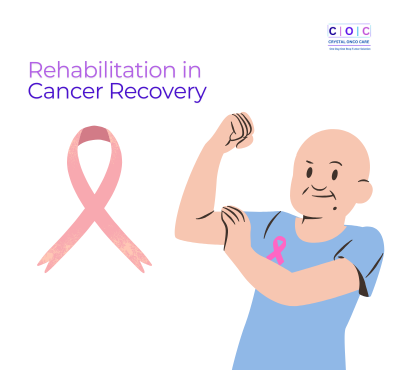1. Rehabilitation Isn’t Optional—It’s Essential
Completing cancer treatment is a major milestone—but many survivors face lasting side effects: persistent fatigue, muscle weakness, reduced mobility, nerve pain, incontinence, and emotional anxiety. Rehabilitation is the bridge from treatment toward real living—restoring function, reducing discomfort, and improving life quality.
Why it matters:
- Up to 90% of survivors report functional issues post-treatment
- Rehab integrates physical, emotional, and practical tools for sustainable recovery
2. Who Gains From Rehabilitation?
Rehab is valuable for anyone affected by cancer, regardless of type or timeline:
- During treatment: To prevent muscle loss and maintain stamina
- Post-surgery: For regaining movement, scar flexibility, and healing
- During survivorship: To tackle long-term effects like lymphedema or pelvic dysfunction
These phases support recovery, preventing secondary complications and promoting independence.
3. What Rehabilitation Looks Like
Rehabilitation is tailored and multidisciplinary. Here’s what it typically includes:
A. Physical Therapy & Therapeutic Exercise
- Customized workouts to restore strength, endurance, and balance
- Range-of-motion exercises to ease scar tightness and improve flexibility
- Cardio-based routines to combat fatigue and improve lung health
Outcomes:
- Reduced fatigue
- Strength improvements
- Greater independence
B. Lymphedema Management
Common after lymph node surgery (e.g., breast or gynecological cancer):
- Manual lymphatic drainage, compression bandages, and exercises improve lymph flow
- Regular skin care reduces infection risk
Effects:
- Reduced swelling
- Better limb function and appearance
- Less risk of cellulitis
C. Pelvic Floor Rehabilitation
Vital after pelvic surgery or radiation (e.g., cervical, prostate cancer):
- Strengthening pelvic muscles
- Bladder and bowel retraining
- Posture correction and core stability
Benefits:
- Reduced incontinence
- Improved sexual function
- Better quality of life
D. Neuropathy & Nerve Symptom Support
- Nerve-gliding exercises, light massage, and sensory retraining help with tingling, burning, and numbness
E. Pain & Scar Mobilization
- Gentle mobilization, postural training, and myofascial techniques reduce long-term pain from surgery or radiation
F. Cognitive & Emotional Rehabilitation
- Memory and concentration support post-chemo (“chemo brain”)
- Counseling and stress-relief techniques to manage anxiety, body image concerns, and PTSD
G. Nutritional Support & Weight Management
- Balanced diets to restore strength, aid healing, and support immunity
- Counseling for weight issues, appetite loss, or post-treatment metabolism shifts
4. The Rehabilitation Flow in Cancer Care
Before Treatment (Prehab)
- Baseline mobility testing
- Gentle strength programs to prepare for surgery
- Early education for faster post-treatment recovery
During Treatment
- Ongoing, low-intensity exercises to minimize functional decline
- Breathing exercises and stretching for chest/radiation effects
Immediately After Treatment
- Focus on restoring shoulder mobility post-breast surgery
- Lymphedema management
- Scar desensitization and breathing strategies
Weeks 4–12
- Progressive resistance training
- Neuropathy, incontinence, or pelvic issue support
- Return-to-work focus and endurance building
Long-Term Survivorship
- Regular exercise for ongoing health
- Maintenance of pelvic, nerve, and limb health
- Emotional support for long-term challenges
5. Real-Life Rehab Success Stories
Case 1: Breast Cancer Survivor
Post-mastectomy, had shoulder stiffness and persistent swelling:
- 12 weeks of physical therapy and lymphatic drainage
- Achieved full range, reduced lymphedema, resumed tennis
Case 2: Cervical Cancer Survivor
Post-hysterectomy, suffered pelvic heaviness and urinary leaks:
- Pelvic floor training and bladder control exercises
- Improved continence and gained back confidence
Case 3: Colon Cancer Survivor
Neuropathy and fatigue after chemotherapy:
- Nerve retraining, endurance exercises
- Regained sensation in toes and returned to evening walks
7. What Research Says
- Physical therapy and multimodal rehab improves function and reduces lymphedema
- Resistance training is safe and beneficial post-breast cancer
- Rehab programs support earlier return to work and are cost-effective
8. Tips for Indian Survivors
- Seek licensed oncologic rehabilitation centers or physiotherapists
- Insist on lymphedema and pelvic floor expertise
- Include gentle yoga or pranayama in routines
- Develop rehab goals and track progress
- Involve family for help and motivation
- Watch for flare-ups during travel, fasting, or seasonal changes
Rehabilitation after cancer is not a luxury—it’s a lifeline. It puts you back in control, rebuilding strength, function, and emotional resilience. Whether you’re just finishing treatment or have been cancer-free for years, rehab supports your journey to thriving—not just surviving.
FAQs
Q1. Can rehab start during cancer treatment?
Absolutely. Starting gentle exercises early can prevent muscle loss and fatigue, and only improves your ability to complete treatment.
Q2. How long until rehab shows benefits?
Many notice improved flexibility and energy within weeks. Greater gains—like strength and bladder control—often take 3–6 months of consistent effort.
Q3. Does insurance cover rehab in India?
Some health plans include post-illness physiotherapy. It’s best to verify with your provider, especially for survivorship-focused rehabilitation.

